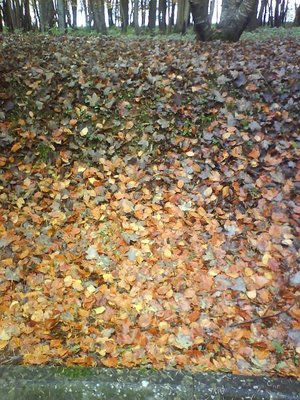Now
I was in a wood of fairly young trees - sixty years old maybe, judging from the thickness of the boles. Most of the trees had dropped their leaves, it was empty and blowy. This was almost over. I was looking ahead, thinking that soon comes the jewel time of mosses.
Then right in the midst of it I noticed a grove of trees whose leaves hadn't yet fallen: yellow-gold. In seven years I had never noticed them before, or rather, I suppose I'd mistaken them for more beeches because they had smooth, grey bark; the leaves began thirty feet above my head. It was only now, when the beeches were leafless, that they briefly stood out: and in fact they were hornbeams, the leaves double-toothed like a bucksaw*. The gradation in autumn is green, yellow, and finally what my book appropriately calls "old gold"; on closer examination, what happens is the main area of the leaf stays yellow but the veins turn chestnut brown.
Now I noticed the subtle brown stripes on the bark, and how the boles snaked their way up. It was raining again and I moved on. Through the wood's veils I still made out that hornbeam orchard. (They were communing in undertones, like when a party starts to break up and you gravitate back to the people you remember arriving with.)
*
REPROOF, BY 'ENGINEER', fl. 1948:
"double-toothed like a bucksaw"
This kind of thing passes muster among the arty set, but a doubly-serrate leaf-margin is altogether different from the sort of arrangement that you have on a bow-saw blade designed for rough logging.


The raker teeth are designed to clear out debris from the channel ripped by the more familiar cutter teeth; therefore are at, or sometimes slightly below, the same level as the cutters. There are no serrated serratures as there are on elms and hornbeams.








